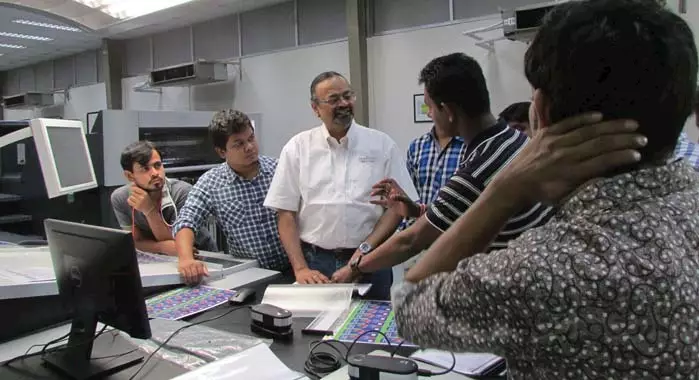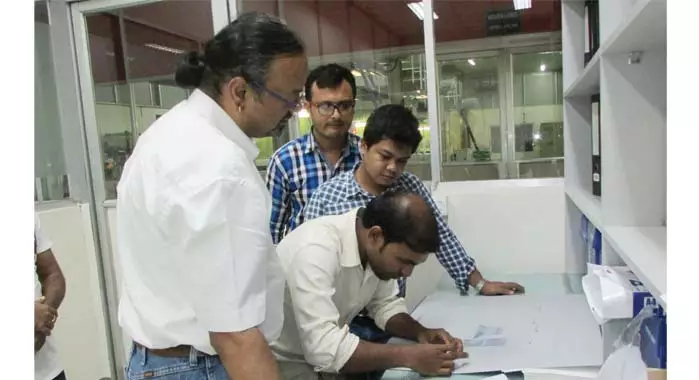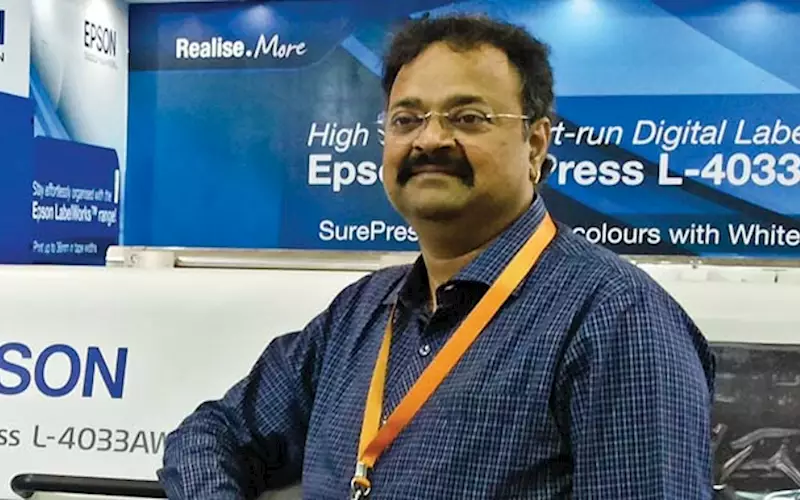Satish Nayak, an Ugra Process Standard Offset (PSO) auditor and the chief technical officer of Bengaluru-based pre-press specialist Bodhi Professional Solutions explains to Rahul Kumar the complexities of colour standardisation and why it is necessity for printers to understand how colours work
During a demo at PrintPack 2017 India, you delivered a message about colour specification, predicting outcomes, measurement and analysis with reporting, and on-press colour management. Who was your first client? What was the experience?
Satish Nayak (SN): We had three clients —Janus (now Edelman), Sai Packaging and Color Dots Prepress Studio. Doing this for the first time in India had its own challenges, but the outcome was much more than what the clients had expected.
Edelman, Sai Packaging and Color Dots Prepress Studio are three different types of operations. So what did Bodhi do with each of them?
SN: All of them vary when it comes to operations but print and colour reproduction is common to all three. The entire printing and colour reproduction industry is a manufacturing industry that needs to follow and deliver industry standards. In the absence of these standards a printer needs to benchmark his own standards according to ISO regulations for his daily work. To enable this we need process control at each stage. It is a common notion that simply buying a new multi-colour printing press will enhance the production. Even new machine needs to be standardised for processes and the first step begins with GIGO – Garbage In Garbage Out. The next step is to bring in the clarity regarding the requirements from the press and this can only be achieved by asking questions. It is a big challenge for printers in India to achieve this clarity and until that happens there is no real standardisation at all. This process standardisation was different for each of our customers mentioned above.
What are all processes a part of this standardisation? What tools did you use?
SN: We had to create a process control system throughout the chain of manufacturing beginning with training for the sales and marketing departments and then the pre-press, press and post-press. This was achieved by using a mix of hardware and software and through a team that collected data.
In the commercial CMYK print environment, a printer opts for ISO conformance (PSO) or G7 (grayscale plus seven colours) protocols for print process control? What is your preference?
SN: The ultimate objective is standardisation in print. G7 or ISO are just the processes based on different methodologies to reach the same objective. Both the processes are established and well accepted across the world. It really does not matter which processes you use.
Most print firms use an aqueous ink Epson graphics printer for proofs. The current generation of Epson features fairly accurate and reliable PrecisionCore print heads and the new ink formulas provide greater gamut and darker shadows. Is it enough?
SN: Epson has become a de facto standard in proofing as it features aqueous pigment-based inks and is quite stable once maintained. This saves a lot of time and money to the printer. Yet we try and take shortcuts and keep burying ourselves into more trouble. As I recall, we were using an Epson proofer almost a decade ago with our software solution where we close loop spot (house colours) and Pantone colours and have been providing inkjet proofs for all spot and Pantone colours quite accurately under the Delta E (a metric for understanding how the human eye perceives colour difference) specification of the customer.
The action of choosing a Pantone spot colour is in fact specifying what you want the printmaker to do. Unfortunately, many professionals in our industry think the colour is a digital specification rather than an ink formulation, and the bridge book is not so well understood; to the point that it can cause misplaced expectations. What is your view about this?
SN: Two things are important here. Colour is a science that is quite interesting to study. While the colour market is driven by the brand owners and graphic designers, printers should have been ahead in mastering this science. What I have found is that the printing fraternity in India does not want to take even baby steps to understand this science. A customer can get unreasonable about colour. And he needs to be educated so that he can reach a reasonable conclusion. Who do you think is better suited to teach his customer than the printer himself?

Nayak (in white): “Colour is a science that is quite interesting to study”
During the jury week at the Printweek India Awards, a brand manager raised a problem with us. She said she had a food product that included both offset printed cartons and flexographic printed bags and gravure pouches. The question she had posted was since the print conditions are different and the kind of inks and printing technologies also vary then how does she standardise?
SN: There is a way out. But it will take up the whole interview to answer that. In short, colour is an appearance science and many things are possible. One needs to understand the tolerance in each manufacturing process.
Why are standardisations in flexo still unattainable?
SN: I don’t think this is the case. Flexo is quite a fixed process and one needs to understand how this print process works and what are its limitations and capabilities. Nowadays, in flexo, a lot can be done and some people are already doing this. The core process of understanding the basic technology has to remain strong and cannot be skipped.
Is GMG OpenColor the best tool for pre-press optimisations (profiles, previews, separations) for print condition and spot colours? Your take on this...
SN: One needs to adopt an open system which can grow with the upgrade in colour profiles. Many years ago I had introduced GMG in India as I was fond of it then. But GMG is a closed proprietary system. Personally, I prefer an open-ended International Color Consortium (ICC)-based system as it is getting better and is moving to the next level of connecting all the dots in a single workflow. ICC is the connecting colour space for all applications and process. These days Bodhi support Alwan Color Hub as it is based on open-ended ICC profiles and has proven to be at the top of the competition. Today, the printer needs to keep abreast with the technology available in the market. A good tip would be to try the technology and ask bold questions to each manufacturer or seller to prove the recommendations/results. Printers can bring challenging files and ask the experts to prove their ability.
Why do you prefer an open-ended ICC based system? What are the advantages?
SN: ICC is the base of all colour management exercises in today’s digital workflow. It is a consortium of all the top players in graphic arts industry who have agreed upon a common way to communicate colour. ICC keeps updating the profiles on a regular basis and the ability to connect becomes easier and better.
What are the advantages of using such an open-ended system?
SN: A proprietary colour management solution is a one-way street. In an open ICC-based solution, one has a big advantage to connect easily to the front-end applications and this allows the ICC-aware applications such as Adobe Photoshop and Adobe Illustrator and Adobe Acrobat and other software to characterise a colour space across the input and output devices. Being open-ended also provides the advantage of integration into a workflow that handles and uses many different applications. This integration leads to predictable results that can be visualised on the computer screens before it goes to print. Almost all graphic arts applications today base the colour management on ICC profiles due to its ability to communicate and connect to other devices or software.

Colour management demonstration
During the meet at PrintPack 2017, one of the speakers said, colour specification is intrinsically the same as process control for print. How do small and medium printing firms set these specifications to the production processes?
SN: As I had mentioned earlier, colour is science and one should begin by training the team. This is already making inroads and is happening at an increasing scale as the print buyers comprising of brand designers and photographers are also getting trained and are aware of it. The printing firms should be willing to spend time, effort and money to empower the team with the knowledge of colour and thus bring in the expected results.
Which standards are a must-know in India today? ISO, PSO, 3DAPv3, TVI curves?
SN: ISO is the final goal. What route the printer takes to achieve this goal is up to him. Finally, once a printer understands the complete process, he can adapt to any of his customer’s requests. The entire process is clearly defined. There is no place for ignorance.
Sometimes the platesetter may provide CIP3 pre-setting, but the press performance does not reflect the assumptions that are factored by the plate setter RIP. How can one resolve this? closed loop system?
SN: Understanding the concept and process is the key factor. It depends upon the level of solution a printer requires for jobs that need to be executed. There are multiple levels. A printer can progress in the correct direction once he understands this.
How frequently must one print a test chart to capture colour characterisation to create profiles for use in pre-press?
SN: This is a must. The frequency depends on how stringent they need to be in their production and how well these presses have been maintained and their usage. In general, I suggest once in every two months. Then either increase or decrease this frequency.
With the type of press automation we have today, has it become easier to achieve grey balance?
SN: Yes. But only through optimisation of standards and that requires process automation. It is a general standard and a printer needs to look at this clearly. ROI calculation on printing presses is a must. If the printing press complies with proper standards, then the output will be more productive and predictive.
Printers need to understand that a workflow is neither a product nor software that can be bought from a vendor. It is a flow of job in their production houses. Once they understand this, putting together the puzzle becomes easier and fun. A new printing press does not guarantee quality print production. The entire process must be standardised or else printing press will put ink on paper.
A lot of vendors claim 25% ink optimisation and savings off their ink bills. Is this tenable?
SN: Ink saving and ink optimisation are byproducts. More important is CMS (colour management systems)/CMP (colour management practices) that are put in place and its settings.
To understand this, I suggest the printers to take the help of a good consultant who can do this hands-on and help them create this process and make this work seamless in the production environment. Tholasi Prints in Bengaluru who is our customer went through these stages and today, it is doing well.
















 See All
See All